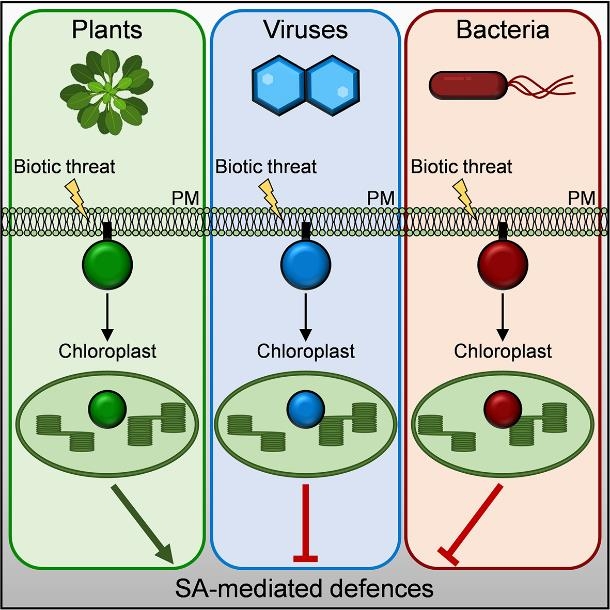A novel pathway connecting the plant cell surface and chloroplasts identified
Scientists at the Shanghai Center for Plant Stress Biology, part of the Center for Excellence in Molecular Plant Sciences of the Chinese Academy of Sciences, have uncovered a novel pathway that transmits information from the plant cell plasma membrane, the layer that delimits the cell and its point of contact with the surrounding environment, to chloroplasts, photosynthetic organelles that can activate downstream responses. This pathway would inform the organelles of the presence of a pathogen threat outside the cell, leading to defence mechanisms being turned on.
Plants are surrounded by menaces, including the attack by pathogens, such as viruses and bacteria, which can cause severe plant diseases. Throughout evolution, plants have developed mechanisms to perceive the presence of a pathogen threat and mount defence responses to deter or eliminate the invading organism. This requires not only the ability to detect the attack, but also to spatially relay this information and orchestrate coordinated responses.
The recognition and responses happen at the cellular level: at the cell surface, molecules indicating the presence of a potential attacker are perceived, raising the alarm. The alert has to then be transmitted to the cell interior and ultimately reach the nucleus, where the plant genes are contained and expressed. Although crucial for plant survival, how this information travels inside the cell is to date not fully understood.
Laura Medina-Puche and colleagues in Rosa Lozano-Duran’s lab have now uncovered a pathway that connects plasma membrane and chloroplasts, which in turn communicate with the nucleus to adjust the expression of genes in order to organize an appropriate defence response. In their article, published on August 24th in Cell, they show how some plant proteins are associated to the plasma membrane, but when the presence of a pathogen is detected, they can move from the cell periphery to the inside of chloroplasts, therefore warning this organelle of the danger. Chloroplasts can then transfer this information to the nucleus in a process called retrograde signalling, activating defence in order to combat the potential invader. Therefore, this route is at least one of the strategies by which the plant cell can transmit information from the outside into the chloroplasts, which can act integrating data and triggering the appropriate downstream responses, in a fast and timely manner.
Pathogens and their hosts are in constant co-evolution, in what is frequently compared to an arms race. Interestingly, the authors of this work have also found that this route to transmit information inside the plant cell can be hijacked by pathogens. Indeed, some proteins from plant viruses and pathogenic bacteria can mimic the behavior of the aforementioned plant proteins, associating to the plasma membrane and moving to chloroplasts when the cell perceives an attack. Once in the chloroplasts, the pathogen proteins can impair the communication between the organelle and the nucleus, hence hampering the activation of defence responses, tilting the balance in favour of the invading microbe. The finding that different kinds of pathogens have evolved similar strategies to take advantage of this plant pathway and utilize it to suppress plant defence suggests a central role in the interaction between plants and microbes.
The discovery of this novel pathway also paves the way to the development of new strategies to engineer plant resistance to pathogen-caused diseases. Pathogens cause dramatic losses in crop production worldwide, posing a threat to food security at a global scale. Results obtained in this work suggest that it is possible to increase the strength of plant defence responses to attacking microbes without affecting productivity in the absence of pathogens, hence potentially improving plant health without compromising plant growth.
Funding: This study has been funded by the Chinese Academy of Sciences, the National Natural Science Foundation of China and the Talent Recruitment Program from the Shanghai government.

Link to the article: https://www.cell.com/cell/fulltext/S0092-8674(20)30885-0
Contact: Rosa Lozano-Duran
Shanghai Center for Plant Stress Biology, Center for Excellence in Molecular Plant Sciences, Chinese Academy of Sciences
Email: lozano-duran@sibs.ac.cn